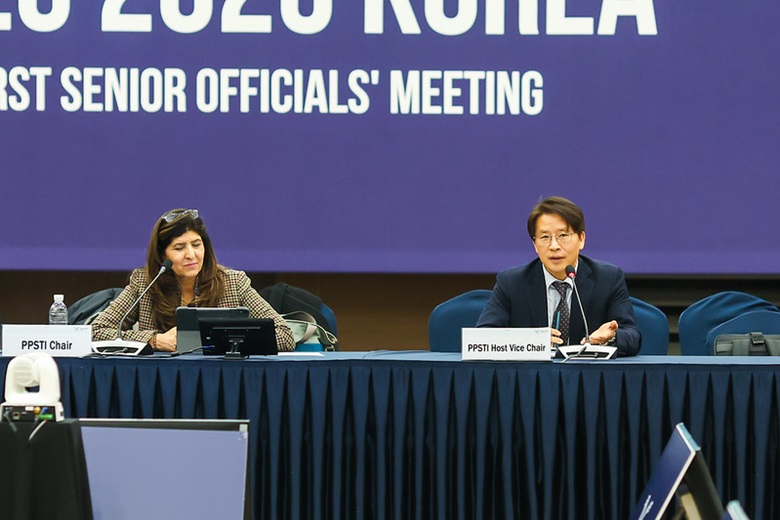GYEONGJU, KOREA – Last month, Berenice Voets, the APEC Policy Liaison Officer for the Association of Pacific Rim Universities (APRU), addressed the APEC Policy Partnership on Science, Technology, and Innovation (PPSTI) meeting. The event, titled “Enhancing Social and Economic Benefits of Emerging Technologies Through Strengthened APEC Collaboration,” convened thought leaders, policymakers, and researchers to discuss the transformative potential of technologies such as Artificial Intelligence (AI), Advanced Biotechnology, and Quantum Technology in driving innovation, economic growth, and inclusive development across the APEC region.
A Timely Dialogue
As emerging technologies continue to reshape the global landscape, the need for collaboration and shared solutions has never been greater. Voets’ presentation, based on APRU’s recent work on Generative AI in Higher Education in collaboration with Microsoft, outlined a compelling vision for how universities can lead the charge in adopting these technologies responsibly and equitably.
The Big Picture: Why Emerging Technologies Matter
The policy dialogue began with an in-depth exploration of the transformative potential of AI, biotechnology, and quantum technologies. AI-powered genetic analysis platforms are revolutionizing healthcare, while quantum computing systems are designing molecules for new medicines. These technologies, once the realm of science fiction, are now converging to create real-world solutions.
However, developing and integrating these technologies requires significant investments and resources. APEC, with its diverse economies and commitment to inclusive growth, is uniquely positioned to drive collaborative initiatives that maximize the social and economic benefits of these technologies across the region.
APRU’s Key Insights: Universities at the Forefront of Change
Voets emphasized the critical role of universities in this rapidly evolving landscape. Drawing from APRU’s recent project on Generative AI, she highlighted how universities are navigating the challenges and opportunities of AI adoption, focusing on innovation and responsibility.
Models for the Future of Universities
Voets outlined four models for how universities might evolve in a generative AI future, with a particular focus on two models deeply connected to science and innovation:
- Research Collaboratories: This model breaks down silos, enabling students to work alongside expert researchers on real-world challenges like climate change or food security. AI facilitates global research collaborations and accelerates knowledge synthesis, preparing students for careers in research and innovation.
- Digital University Consortia: Similar to the “Star Alliance” of higher education, this model involves institutions banding together to create a global network of shared resources, expertise, and AI-powered learning tools. This approach offers personalized learning experiences, seamless cross-institutional enrollment, and a focus on equipping students with marketable skills.
These models are not just theoretical—they are a call to action for universities to rethink their roles in an AI-driven world.
The CRAFT Framework: A Roadmap for Responsible AI Adoption
Voets introduced the CRAFT framework, a practical guide for universities navigating the opportunities and risks of generative AI. The framework emphasizes four core areas:
- Culture: The relational, human, and altruistic values that underpin higher education and our societies’ use in an AI enabled world.
- Rules: Flexible and adaptive governance frameworks to ensure responsible AI use.
- Access: Equity and accessibility to prevent the amplification of existing biases.
- Familiarity: AI literacy for both students and faculty, encompassing technical skills, critical thinking, and ethical reasoning.
- Trust: Transparency and ongoing dialogue among stakeholders to build trust in AI systems.
The CRAFT framework underscores that while AI offers incredible possibilities, its adoption must be guided by ethical principles and a commitment to inclusivity.
The Road Ahead: Collaboration and Inclusive Growth
The policy dialogue focused on identifying challenges and finding solutions. Expected outcomes included strengthened collaboration among APEC member economies, region-specific solutions tailored to societal needs, and increased investment in technology-driven initiatives. The goal is a more inclusive, innovative, and sustainable APEC region.
Voets’ presentation highlighted the critical role of universities in this journey. As hubs of research and innovation, universities have a unique responsibility to prepare students for an AI-driven future and ensure that technological advancements benefit society as a whole.
A Call to Action
The APEC PPSTI meeting underscored the potential of emerging technologies to transform our world while highlighting the importance of collaboration, ethical considerations, and equitable access. Voets’ insights provided a roadmap for universities to navigate this complex landscape, balancing innovation with responsibility.
As we look to the future, it is clear that the adoption of emerging technologies is not just a technical challenge—it is a societal one. By working together, APEC member economies can harness the power of AI, biotechnology, and quantum technologies to create a more inclusive and sustainable future for all.

